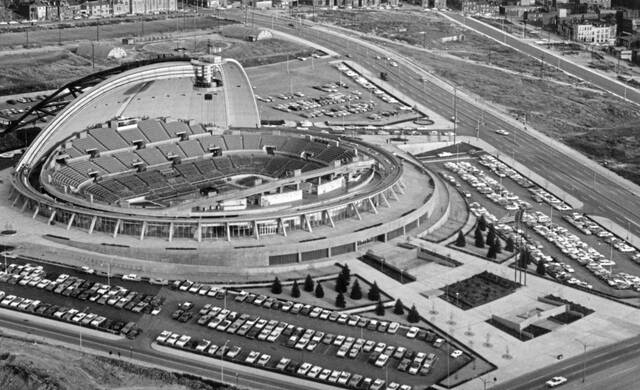Civic Arena, Roberto Clemente to be memorialized with historical markers
The old Civic Arena is one of several historic sites to be commemorated with new blue historical markers, the Pennsylvania Historical and Museum Commission decided Thursday.
Nearly 2,600 cast-aluminum markers found throughout the state— including 163 throughout Allegheny County — tell the stories of Native Americans, colonization, politics, athletes, entertainers, equality movements and other key topics.
The Pennsylvania Historical and Museum Commission this week decided to add 45 more, including another seven in Allegheny County.
One will tell the story of the Civic Arena — also dubbed The Igloo — which was dedicated in 1961 and for decades hosted the circus, musical acts and sporting events.
The Civic Arena, later renamed Mellon Arena, was also home to the Pittsburgh Penguins. Its 5.5 million-pound retractable roof was the largest of its kind when the stadium was build.
Despite a push from some preservationists to save the structure, the Civic Arena was torn down over two years, starting in 2011, after PPG Paints Arena — originally called Consol Energy Center — was built to replace it.
The site in Pittsburgh’s Lower Hill District that once housed the arena is now being redeveloped with a music venue, public safety center and office tower.
Other new markers set to be installed in Allegheny County will honor:
- Charles E. “Commando” Kelly, who received the Congressional Medal of Honor for his service in the U.S. Army in World War II
- George B. Vashon, a scholar, poet and abolitionist who became New York’s first Black attorney after being rejected by the Pennsylvania bar because of his race
- Olive Thomas, a silent film star
- Roberto Clemente, a Hall of Fame Pittsburgh Pirate remembered for his humanitarian efforts
- St. Benedict the Moor Church, a historically Black Catholic Church in Pittsburgh’s Hill District
- The Fraternal Order of Police, which saw its first lodge formed in Pittsburgh in 1915
Exact marker locations have not yet been determined. Most are situated where someone lived or made an impact, at the spot an event took place or at a particular site, such as with the Civic Arena, said Sean Adkins, a spokesperson for the Pennsylvania Historical & Museum Commission.
Some dedications for the new batch of markers may not happen until next year, Adkins said.
The historical marker program, which was established about 80 years ago, relies on public nominations. This week’s new markers are the first to be approved in two years, according to the commission.
“Pennsylvania’s historical markers are more than roadside signs — they are living touchpoints that connect people with the stories of our past, inviting every person who passes by to pause, learn, and take pride in the shared heritage that belongs to us all,” Pennsylvania Tourism Deputy Secretary Anne Ryan said.
Julia Burdelski is a TribLive reporter covering Pittsburgh City Hall and other news in and around Pittsburgh. A La Roche University graduate, she joined the Trib in 2020. She can be reached at jburdelski@triblive.com.
Remove the ads from your TribLIVE reading experience but still support the journalists who create the content with TribLIVE Ad-Free.

